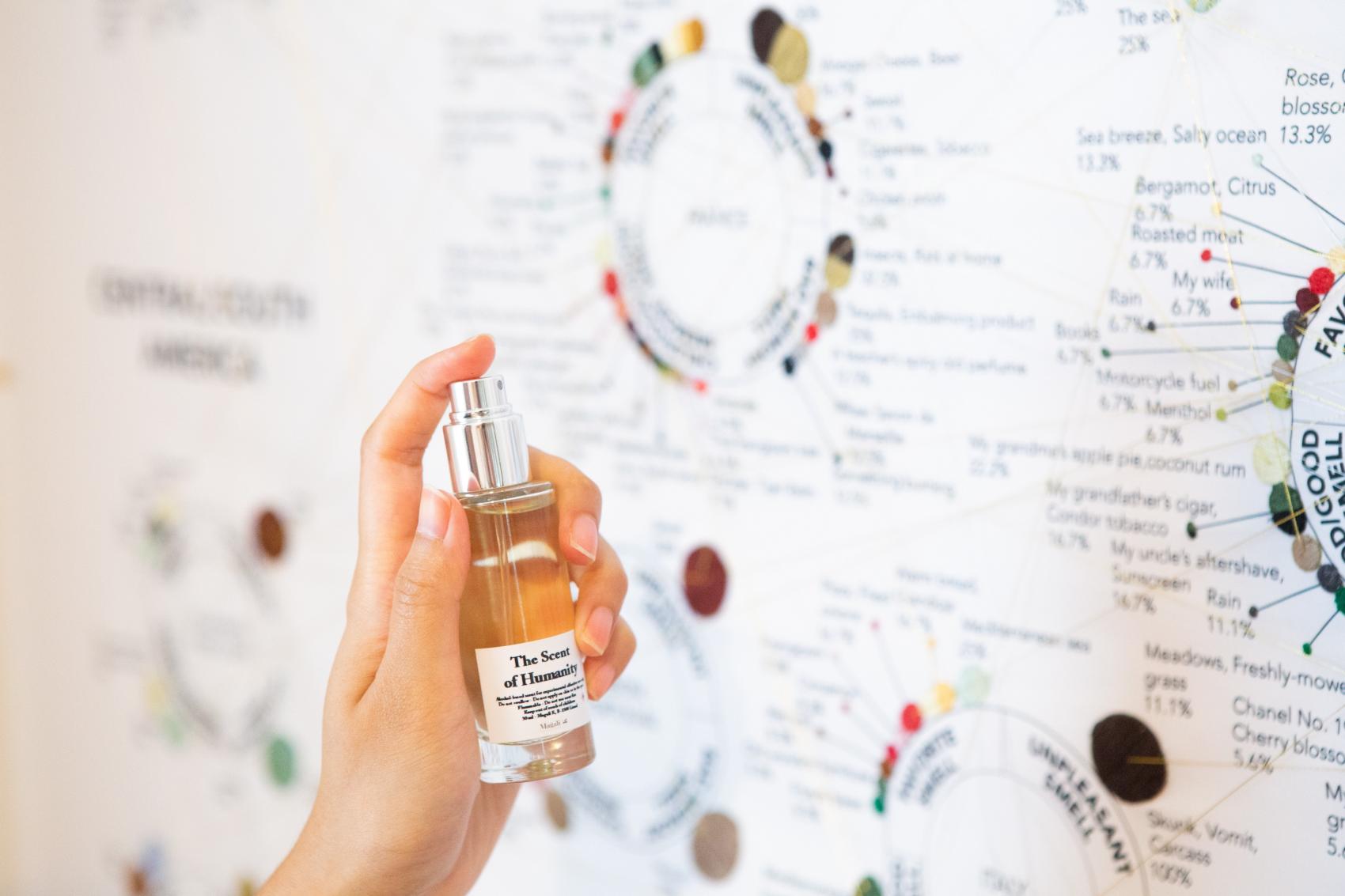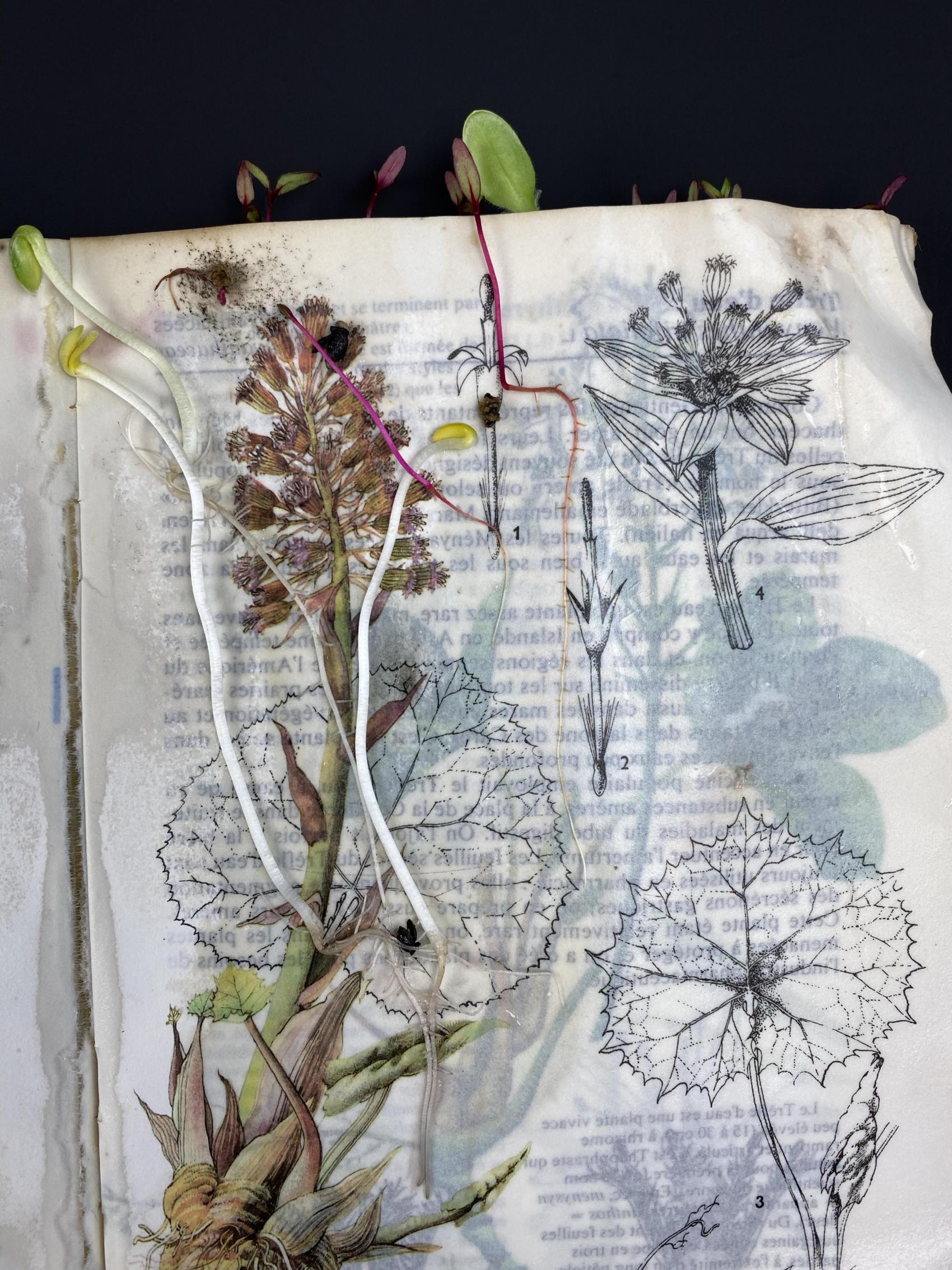Olfactory Mapping: A Scented Narrative of Humanity
2020 (140cm x 100cm digital print on cotton, scented embroidery)
The inspiration behind this project came from my fascination of the human senses and how sensory stimulation can evoke lost memories in certain individuals with dementia. The most imperative of the 6 senses, the sense of smell, is the main topic of my artistic research. This project tackling the olfactory system questions how it defines the way we think and act by interacting with emotional memory. The purpose of this research was to highlight the significance of the olfactory system in sociological contexts by designing an olfactory mapping system, and to define its potential in the fields of arts and sciences, through the mapping of olfactory (smell) descriptions with relevant anthropological and linguistic links, using memory as support. This 140cm x 100cm digital print on 100% cotton contains the embroidered olfactory data of more than 50 people who participated in a qualitative survey from over 17 countries and 30 cities. The information collected from the study is visualized into a tangible anthropogenic odor map completed and linked with scented thread, based on the participants’ demographics, geographical regions and personal relationship with scent. Golden threads link all our commonalities in smell memory together, while silver threads connect our place of origin with where we currently reside.
In order to complete and translate the collected anthropological data of hedonic smell descriptions into a physical entity, I collaborated with olfactive designer, Magali K, to create a bespoke fragrance entitled “The Scent of Humanity”, comprising of the dominant smell descriptions derived from each continent. The 5 scents defining each continent are: Asia: Frangipani; Europe: Freshly cut grass; North America: Fresh laundry; Central/South America: The sea; Africa: The rain; and a 6th smell of commonality: Sweat. The notion is to experiment whether these scents harmoniously blend together within an olfactive point of view, with the purpose of displaying an artistic and olfactive representation of the collective smell of humanity. Each designated scent is applied to relevant embroidered smell descriptions belonging to the countries of each continent, providing an experience of sensory stimulation, activating the visual, tactile and olfactory senses all at once.
Knowing that smell is able to evoke lost memories even in individuals with Alzheimer’s, this project demonstrates an understanding of how we are able to remember a smell without ever smelling it again, but only through the recollection of childhood and mostly positive memories, indicating the experience as humanity’s version of time travel. This artwork is another way of capturing and visualizing an intangible realm such as smell memory in an informative, meaningful and tactile way. The main questions that could be derived from viewing and experiencing the multi-sensorial artwork is personal, existential and self-reflective: “Where am I in this equation, how can I identify myself, and who can I relate to?”.
For more technical information on scent, a fragrance wheel is to be viewed in conjunction with the “Scented Narrative of Humanity” (odor map). My version comprises of 30 scents based on odor information extracted from scientific sources. On the wheel, the category that each scent (odor profile) falls into, along with their reference material (chemical name), chemical compounds (structure) and chemical equation, is visualized. Illustrations of scent origins along with their scientific name are also included. In order to accurately identify the correct colors within an odor profile, hex codes have been assigned to each color along with their official web color names. By representing the chemical structures in an illustrative form, scientific data was transformed into an artistic interpretation without losing factual information.
About Eriya Miura
Eriya Miura is a fashion designer and visual artist with primary focus on conceptual and informative design with a sophisticated hybrid to its forms.
She received her BFA from Parsons School of Design in New York, and MA degree from LUCA School of Arts in Brussels.
With a background in fashion and textiles, Eriya Miura’s design philosophy is to let the materials tell their own story. Her emphasis on storytelling through the medium of textiles transforms the ethereal into the tangible, integrating unconventional yet traditional methods of process and construction.
The combination of craftsmanship, textile manipulations and digital design are important to the concept of her works. The sometimes moody, but always emotional atmosphere customarily consists of a dreamy, flowing color palette, novel fabric textures and organic silhouettes.
Contact

04/08/1998
Living on the edge
Climate change is een globaal probleem, dat niet meer te miskennen valt. In deze masterproef wordt de klimaatverandering onderzocht vanuit het standpunt van één van de meest fundamentele, biologische processen: symbiotische structuren. Symbioses staan garant voor een klimatologische diversiteit, en zijn dus een zeer belangrijk aspect binnen climate change. Experimenten vormen de kern van deze master- proef. De symbiotische processen werden nauwkeurig onderzocht, en ze werden vervolgens gebruikt om werken te creëeren die deze essentiële processen op een visueel impactvolle manier onder de aandacht brengen. Boeken - als vergankelijke dragers van informatie - werden de dragers van deze symbioses. Hoe creëer ik een symbiose tussen een levend organisme en een niet-levend object?
De titel van dit werk - Living on the edge - refereert zowel naar de boeken die dienen als drager van de symbiose, als naar de riskante situatie waar we ons vandaag de dag in bevinden. De organismen/materia- len die gebruikt werden voor de symbiose, zijn gebaseerd op vijf specifieke thema’s binnen climate chan- ge: het stijgen van de zeespiegel, ontbossing, watervervuiling, de verzuring van water en luchtvervuiling. De experimenten werden ondersteund door een uitgebreide research omtrent deze onderwerpen.
Het resultaat van dit onderzoek - een symbiose tussen een organisme/materiaal en een boek - zet de kijker aan tot zelfreflectie. De boeken verliezen hun functie als informatiedrager en verspreider, omdat ze vaak niet meer leesbaar zijn. De informatie is nog wel aanwezig, maar niet meer raadpleegbaar. Door de bevreemdende combinatie tussen een boek en levende organismen of materialen, ontstaat er een openheid bij de kijker. De sculpturen zijn conversation pieces, en daardoor verkrijgen ze opnieuw hun functie als informatieverspreider. De boodschap is belangrijk en dringend, maar er wordt niet met de vinger gewezen. De kijker kan op zijn niveau reflecteren over het onderwerp.
Petrified book: Voor het thema ‘het stijgen van de zeespiegel’ werd er gewerkt met borax, om verzilting na te bootsen. Deze ‘versteende’ boeken zijn een metafoor voor wat er gebeurt met onze vruchtbare bodem, wanneer deze overspoeld wordt met zout water. Net zoals planten de grond nodig hebben om hen te voeden, heeft de mens boeken nodig om het brein te voeden. Door de kristallisatie zijn de boeken onleesbaar geworden. De informatie mag dan niet volledig verdwenen zijn, ze is voor eeuwig opgesloten en kan niet meer geraadpleegd worden. Net zoals planten, die door verzilting soms niet volledig verdwijnen, maar stoppen met groeien en zo een schim blijven van hun vroegere zelf.
Fragmented book: Voor het thema ‘ontbossing’ werd er gewerkt met kiemplantjes. De plantjes die ont- kiemen tussen de pagina’s creëren een visualisatie van een ontbost en verbrand gebied, waar na verbran- ding talloze nieuwe plantjes ontspruiten. Het boek, dat afkomstig is van een boom, brengt balans in de cylcus, door zelf als voedingsbodem te dienen voor dit nieuwe leven.
Overpowered book: Voor het thema ‘watervervuiling’ werd er met algen gewerkt, een overmatige algengroei is immers een bekend effect van watervervuiling.
Acidified book: Voor de ‘verzuring van water’ werd er logischerwijs met zuur gewerkt. Er werd voor- namelijk gewerkt met de zuren die aan de basis liggen van zure regen: salpeterzuur (60%) en zwavel- zuur (90%). De effecten van deze zuren op een boek zijn dezelfde als op bloemen, bomen en planten. Bladeren scheuren, verkleuren en brokkelen af bij aanraking.
Poisoned book: Voor het thema ‘luchtvervuiling’ werd er gewerkt met schimmels, omdat de effecten van het inademen van schimmelsporen identiek zijn aan die van het inademen van luchtvervuiling. Wanneer men het ‘beschimmeld’ boek wil lezen, zal men de effecten van luchtvervuiling aan levende lijve ondervinden.
Contact:
elinewolters_graphicdesign (instagram)
